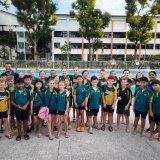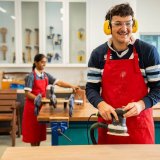Managing Disruption In Secondary School
WRITTEN BY NICOLE GLISSON, COORDINATOR OF POSITIVE EDUCATION, TEACHER OF DRAMA AND THEATRE, (OBSERVATIONS SHARED BY JUSTINE GARDINER, RICHARD HEAZLEWOOD AND MANY AIS TEACHERS AND PARENTS).
Insights into Home Based Learning (HBL)
I write this article from the same desk, in the same chair, looking out of the same window that I have been for over a month; not where I envisaged I would spend Term 2 of 2020. It’s been nearly six weeks since I last saw my students and colleagues in person and it may be a number of weeks yet until I see them again.
How did we prepare for HBL?
As we began to see the effect that Covid-19 was having on the world around us early in Term 1, we developed our ‘Continuity of Instruction’ plan. We had a number of strategies ready to respond to whatever situation arose.
Fortunately, we had already been exploring and developing the use of the Google Suite for some time as a school. Google Meet has allowed us to retain the human aspect of teaching in HBL. As students’ faces pop onto the screen at the beginning of a lesson it is wonderful to engage in the informal conversations that we would have at school. I have seen most students’ pets, have conducted classes whilst wearing crazy wigs and have taken lots of physical brain breaks.
What have been the challenges of HBL?
Connection and space!
Wifi connectivity is one issue but human connection has been the bigger challenge. Humans are social beings. We thrive together. So during this time we miss our friends, we miss the freedom of freely going out and we miss the energy of learning together. On the other hand being confined in the one space with the same people for a long period of time also has challenges. In my family, there are two adults working from home and two teenagers learning from home; we all share the ups and downs of this new style of education. We have set up multiple workstations, often vying for privacy, quiet and workspace.
What have teachers learnt?
We have a new appreciation for the importance of routine and structure. STRIVE is our lesson to connect in homerooms each morning, sharing stories, building relationships and learning skills for living well. Our daily STRIVE check-ins and maintaining the timetable has reinforced some normalcy. We have learnt to be innovators, embracing a growth-mindset approach to adapting content, teaching styles and expectations each day.
We’ve also reaffirmed our commitment to prioritise wellbeing: our students’ and our own. ‘Academic wellbeing’ is a concept we have discussed at length at AIS and never has the relationship between how we feel and how we do been clearer. Our Wellbeing Team (including Heads of Year) have been proactive in identifying who is flourishing and who needs support. Our School Counsellors have also continued to be wonderfully supportive and available online for students and staff alike.
Many students (especially Years 11 and 12) have enjoyed taking more control over their own learning, being able to prioritise and manage their tasks and spend more time on certain tasks. Students can also have one-on-one chats with their teachers to develop ideas, ask questions or just check-in.
This video was created by the secondary school prefects; it speaks to the staff/student relationship and we are so proud to be a part of their learning journey.
Parents’ reaction to HBL?
This has been very positive. This week we conducted our first online Parent Teacher Conferences and, if the positive feedback is anything to go by, it may not be the last. The following parent comment gets to the heart of the AIS Way:
Every single teacher began the interview asking how the kids were going, how they were feeling about HBL and we really felt the engagement level, knowledge about the child and care was at the top level.
We dearly miss being at school but we have learnt that we can thrive anywhere when we have such a strong sense of belonging to a community like AIS. #WeAreAIS






